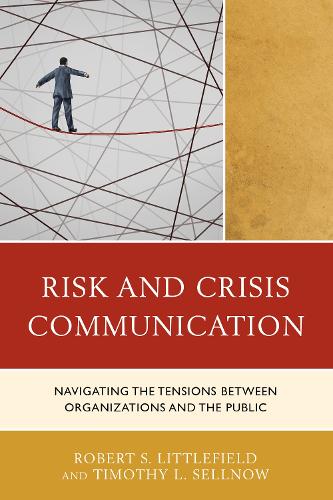
Risk and Crisis Communication: Navigating the Tensions between Organizations and the Public
(Hardback)
Available Formats
Publishing Details
Risk and Crisis Communication: Navigating the Tensions between Organizations and the Public
By (Author) Robert Littlefield
Edited by Timothy L. Sellnow
Contributions by Laura C. Farrell
Contributions by Tara B. Freed
Contributions by Nigel Haarstad
Contributions by Robert S. Littlefield
Contributions by Elizabeth L. Petrun
Contributions by Shalindra Rathnasinghe
Contributions by Jessica Rick
Contributions by Holly A. Roberts
Bloomsbury Publishing PLC
Lexington Books
5th November 2015
United States
Classifications
Professional and Scholarly
Non Fiction
Media studies
658.4056
Physical Properties
Hardback
160
Width 158mm, Height 238mm, Spine 19mm
354g
Description
Risk and Crisis Communication addresses how the interaction between organizations and their stakeholders manifests during a risk or crisis situation. Littlefield and Sellnow contend that when best practices are considered, there are certain tensions to which an organization responds. These tensions are similar to those experienced among individuals when managing their relationships. As such, Littlefield and Sellnow apply an interpersonal theory, known as relational dialectics (RDT), to risk and crisis communication and examine the outcome from the vantage point of the officials and the public. Previous research has focused on top-down, sender-oriented communication to evaluate the effectiveness of particular strategies used by spokespeople to repair public image or relay an apology. In contrast, Littlefield and Sellnows approach relies on culture-centeredness and suggests how cultural elements may have influenced the kinds of tensions each organization faced. Risk and Crisis Communication exemplifies the use of RDT through seven case studies, each focusing on one of the tensions, making it of interest to both scholars and organizational leaders.
Reviews
This book investigates an important but hitherto underdeveloped area: risk and crisis communication. Littlefield and Sellnow use relational dialectics theory, focus on culture as a key element, and investigate these ideas in multiple contexts. Risk and Crisis Communication is a welcome addition to the literature. -- William Benoit, Ohio University
Littlefield and Sellnow have assembled an impressive set of essays that provide insight into the cultural and relational dimensions of crisis and risk communication. The case studies included provide insight for both scholars seeking to understand these important phenomena and for practitioners seeking to communicate in a more culturally sensitive and effective way. The tensions identified and described in this volume will provide a useful analytical frame for crisis and risk communication. -- Matthew W. Seeger, Wayne State University
A fresh approach toward a better understanding and explanation of the multifaceted yet navigable tensions inherent in risk and crisis situations that organizations and individuals must address. This book is applicable for students, junior and senior scholars, and practitioners who are searching for a distinctive perspective. -- Michael James Palenchar, University of Tennessee
Author Bio
Robert S. Littlefield is professor in the Department of Communication at North Dakota State University. Timothy L. Sellnow is professor in the Nicholson School of Communication at the University of Central Florida.
